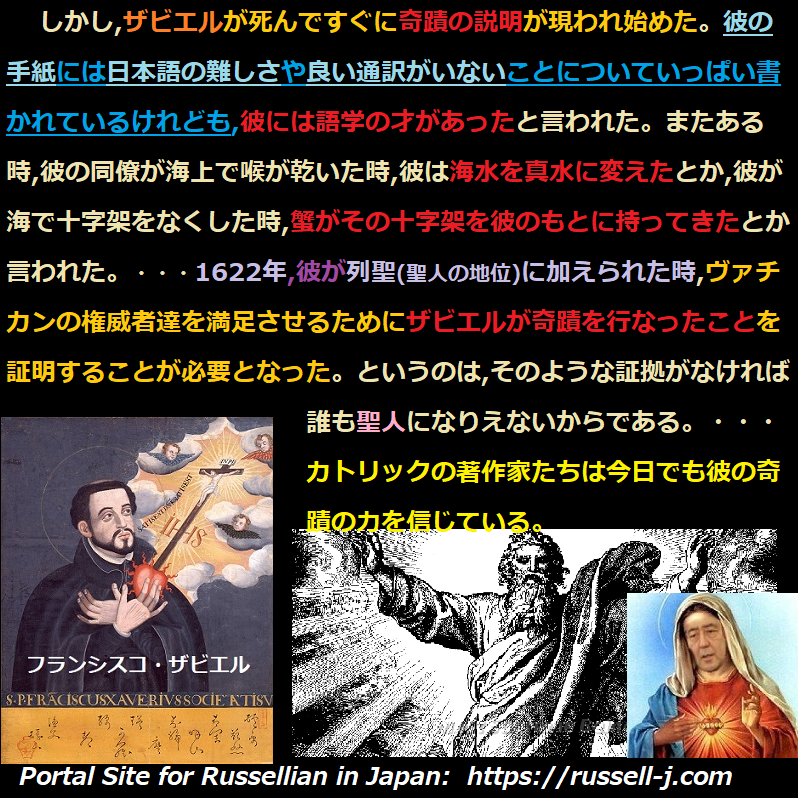
聖フランシスコ(注:1506-1552:カトリック教会の司祭・宣教師で,イエズス会の創設者の一人で,日本ではフランシスコ・ザビエルという名前で知られている。通常,聖フランシスコというとアッシジのフランシスコを指すがここでは別人)は,インド,中国,日本で多くの年月を過し,とうとう1552年に亡くなった(at last met his death)。彼と彼の同僚は,自分たちの仕事(任務)を説明する多数の長文の手紙 -それは今も残っている- を書いたが,そのいずれにも,聖フランシスの生存中のものに関する限り,奇蹟の力(を自分が持っていること)を主張しているものはない(but in none of them, so long as he was still alive, is there any claim to miraculous powers. → but so long as he was still alive, there is any claim to miraculous powers in none of them. 倒置に注意 )。ホセ・デ・アコスタ(注:Joseph Acosta = Jose de Acosta, 1540-1600 スペインの博物学者で,アメリカ大陸の初期記録者の一人) -ザビエルと同じイエズス会士でペルーにいる動物に大変当惑- は,これらの伝道(宣教活動)が異教徒を(キリスト教に)改宗させる努力において奇蹟に助けられていなかったことを明確に主張している。しかし,ザビエルが死んですぐに奇蹟の説明が現われ始めた。彼の手紙には日本語の難しさや良い通訳がいないこと(the paucity of good interpreters)についていっぱい書かれているけれども,彼(ザビエル)には語学の才(gift of tongues)があったと言われた。(また)ある時,彼の同僚が海(上)で喉が乾いた時,彼(ザビエル)は海水を真水に変えたとか,彼が海で十字架をなくした時,蟹がその十字架を彼のもとに持ってきたとか,言われた(そうカニ,=冗談)。後の版(解釈)によると,彼は大暴風雨を鎮めるために十字架を船外へ(overboard 海中に)投げた(ことになっている)(he threw the crucifix overboard to still a tempest)。1622年,彼が列聖(注:キリスト教会において,信仰の模範となるにふさわしい信者を聖人の地位にあげること)に加えられた時(when he was canonized),ヴァチカンの権威者達を満足させるためにザビエルが奇蹟を行なったことを証明することが必要となった。というのは,そのような証拠がなければ,誰も聖人になりえないからである。ローマ教皇はザビエルの語学の才を公認し,特に彼が油の代りに聖水(holy water)を用いてランプを灯したという事実に感銘した(新地出版社刊の津田訳では,”holy water” を “hot water” と見間違えたらしく,「湯」と訳されている(笑))。この教皇は,ガリレオが言ったことは信じがたいとした教皇 -ウルバヌス八世- (と同一人物)であった。この伝説はどんどん成長し,ついには,ブーウール神父(Dominique Bouhours, 1628-1702)によって1682年に出されたザビエルの伝記の中では,この聖人(ザビエル)は生涯において14名の人を死から蘇えらさせたと(raise ~ the dead 眠りから覚ます;よみがえらせる),我々は学ぶ(知る)ことになった。カトリックの著作家たちは今日でも彼の奇蹟の力を信じている。こうして,イエズス会のコールリッジ神父は,1872年に出版した伝記の中で,ザビエルの語学の才を再確認した(のである)。 この例からみても(わかるように),ザビエルの場合より記録の少ない時代に,驚異的な出来事(marvels)に与えられた説明が如何に信頼がおけないものかは明らかである。
Chapter 4: Demonology and Medicine, n.3
St. Francis spent many years in India, China and Japan, and at last met his death in 1552. He and his companions wrote many long letters, still extant, giving accounts of their labours, but in none of them, so long as he was still alive, is there any claim to miraculous powers. Joseph Acosta — the same Jesuit who was so puzzled by the animals of Peru — expressly asserts that these missionaries were not aided by miracles in their efforts to convert the heathen. But soon after Xavier’s death accounts of miracles began to appear. He was said to have had the gift of tongues, although his letters are full of the difficulties of the Japanese language and the paucity of good interpreters. It was said that, on one occasion when his companions were thirsty at sea, he transformed salt water into fresh. When he lost a crucifix in the sea, a crab restored it to him. According to a later version, he threw the crucifix overboard to still a tempest. In 1622, when he was canonized, it became necessary to prove, to the satisfaction of the Vatican authorities, that he had performed miracles, for without such proof no one can become a saint. The Pope officially guaranteed the gift of tongues, and was specially impressed by the fact that Xavier made lamps burn with holy water instead of oil. This was the same Pope — Urban VIII — who found what Galileo said incredible. The legend continued to grow, until, in the biography published by Father Bouhours in 1682, we learn that the saint, during his lifetime, raised fourteen persons from the dead. Catholic writers still credit him with miraculous powers ; thus Father Coleridge, of the Society of Jesus, reaffirmed the gift of tongues in a biography published in 1872. From this example it is evident how little reliance can be placed upon accounts of marvels in periods when the documents are less numerous than in the case of St. Francis Xavier.
出典:Religion and Science, 1935, chapt. 4:
情報源:https://russell-j.com/beginner/RS1935_04-030.HTM
